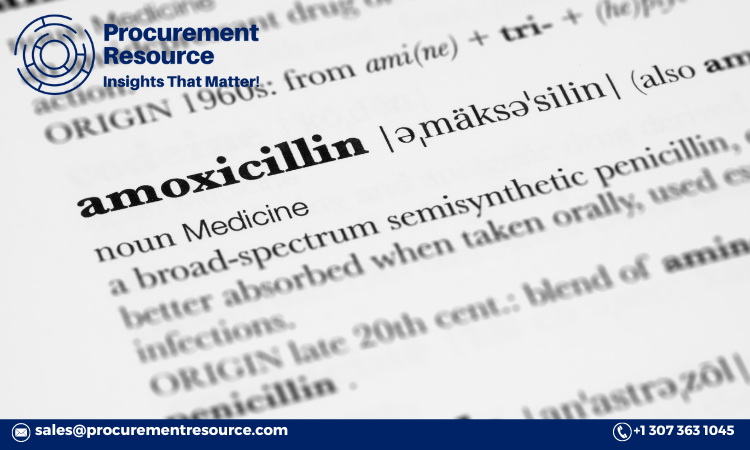
Amoxicillin, a widely used antibiotic, is an essential medication in treating bacterial infections. Over the years, the price trend of amoxicillin has been a focal point for healthcare providers, patients, and policymakers. Understanding the dynamics behind its pricing is crucial for ensuring accessibility and affordability. This report delves into the recent trends in amoxicillin prices, exploring factors influencing these changes and providing a forecast for the future.
Forecast Report
Forecasting the price trends of pharmaceuticals like amoxicillin involves analyzing historical data, market conditions, and various external factors that could influence the market. For amoxicillin, several elements play a pivotal role in shaping its price trajectory, including raw material costs, production capabilities, regulatory changes, and market demand.
Request For Sample: https://www.procurementresource.com/resource-center/amoxicillin-price-trends/pricerequest
Historical Data and Recent Trends
Historically, the price of amoxicillin has experienced fluctuations due to varying factors such as changes in production costs and shifts in supply and demand dynamics. Over the past five years, the price has seen a steady increase, primarily driven by rising raw material costs and heightened demand due to global health crises like the COVID-19 pandemic. The pandemic not only increased the demand for antibiotics but also disrupted the supply chain, causing temporary price spikes.
Influencing Factors for Future Trends
- Raw Material Costs: The cost of raw materials, especially key ingredients like 6-aminopenicillanic acid (6-APA), significantly impacts amoxicillin prices. Any fluctuations in the prices of these raw materials will directly influence the end product’s cost.
- Production Capabilities: Manufacturing capacities and technological advancements in the production process can affect the supply of amoxicillin. Increased efficiency and higher production yields can potentially lower prices.
- Regulatory Environment: Regulatory changes, including stricter quality controls and new guidelines for antibiotic usage, can affect the production cost and availability of amoxicillin.
- Market Demand: Demand fluctuations due to seasonal variations in bacterial infections, emergence of new diseases, or changes in prescription habits can also impact amoxicillin prices.
Price Forecast
Based on the current market analysis and the influencing factors, the price of amoxicillin is expected to stabilize in the near term, with a slight upward trend due to increasing raw material costs and ongoing regulatory changes. However, advancements in production technology and potential new entrants in the market could provide downward pressure on prices, leading to more competitive pricing.
Market Analysis
The amoxicillin market is characterized by several key players, including major pharmaceutical companies and generic drug manufacturers. The competition among these players significantly influences the price and availability of amoxicillin.
Key Market Players
Major pharmaceutical companies like Pfizer, GlaxoSmithKline, and Teva Pharmaceuticals dominate the amoxicillin market. These companies invest heavily in research and development, ensuring a steady supply of high-quality amoxicillin. Additionally, numerous generic manufacturers produce amoxicillin, contributing to market competition and price variations.
Market Dynamics
- Supply Chain Stability: The stability of the supply chain, including the availability of raw materials and manufacturing capabilities, plays a critical role in determining amoxicillin prices. Disruptions in the supply chain, such as those caused by the COVID-19 pandemic, can lead to significant price fluctuations.
- Regulatory Policies: Government regulations and policies regarding drug pricing, quality control, and import-export restrictions impact the overall market dynamics. Stricter regulations can increase production costs, affecting prices.
- Healthcare Policies: Changes in healthcare policies, insurance coverage, and reimbursement rates also influence the demand and affordability of amoxicillin.
- Global Health Trends: The emergence of new bacterial strains and global health crises can spike the demand for antibiotics, including amoxicillin. This increased demand can drive up prices temporarily.
Competitive Landscape
The competitive landscape of the amoxicillin market is influenced by factors such as patent expirations, the entry of new generic drugs, and mergers and acquisitions among pharmaceutical companies. Patent expirations of branded amoxicillin products open the market for generic versions, increasing competition and potentially lowering prices. Conversely, mergers and acquisitions can consolidate market power, influencing pricing strategies.
Latest News
Keeping abreast of the latest news and developments in the pharmaceutical industry is essential for understanding the amoxicillin price trend. Recent news highlights several key events and trends impacting the market:
COVID-19 Impact
The COVID-19 pandemic has had a profound impact on the pharmaceutical industry, including the amoxicillin market. The increased demand for antibiotics to treat secondary bacterial infections in COVID-19 patients led to temporary shortages and price spikes. However, as the pandemic stabilizes, the supply chain is gradually recovering, and prices are stabilizing.
Regulatory Updates
Recent regulatory updates from the U.S. Food and Drug Administration (FDA) and other global regulatory bodies emphasize stricter quality controls and monitoring of antibiotic production. These regulations aim to ensure the safety and efficacy of antibiotics but may also increase production costs, influencing prices.
Technological Advancements
Advancements in pharmaceutical manufacturing technologies are improving the efficiency and cost-effectiveness of amoxicillin production. Innovations in bioprocessing and automation are expected to enhance production capacities and reduce costs, potentially lowering prices in the long term.
Market Entrants
The entry of new players in the amoxicillin market, particularly generic drug manufacturers from emerging economies, is increasing competition and contributing to more competitive pricing. These new entrants bring fresh perspectives and innovations, further influencing the market dynamics.
Environmental Concerns
Environmental concerns related to the disposal and impact of antibiotics on ecosystems are gaining attention. Governments and regulatory bodies are implementing stricter guidelines for environmentally sustainable production and disposal of antibiotics, which could affect production costs and prices.
Conclusion
The price trend of amoxicillin is influenced by a complex interplay of factors, including raw material costs, production capabilities, regulatory changes, market demand, and global health trends. While the current forecast indicates a slight upward trend in prices, advancements in technology and increased market competition could provide downward pressure. Staying informed about the latest market developments and regulatory updates is crucial for stakeholders to navigate the dynamic landscape of amoxicillin pricing.